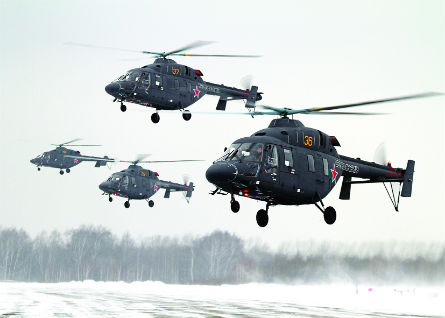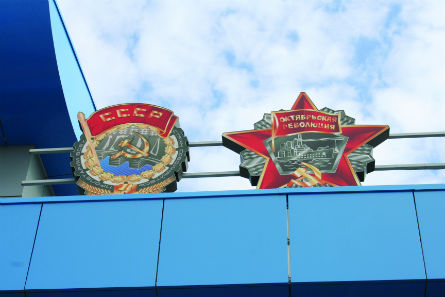Customers doing business with AgustaWestland, Bell, Eurocopter or Sikorsky enjoy all-under-one-roof comfort; these vertically-integrated suppliers sell the machine, train the pilots and mechanics, provide the spare parts, design upgrades or modifications and back everything with a competitive warranty. They are not merely selling machines; they are selling a seamless operating lifetime. Two other big names in rotorcraft, the Russian brands Mil and Kamov, are not the same kind of beasts.
At least, that is, until the last couple of years. The disintegration of the Soviet Union in 1992 ushered in an era many of its former citizens regard as a sort of Dark Ages of economic collapse and political upheaval. The fact that, 20 years on, rump Russia is still in some political turmoil as it continues to invent a new form of government is an indicator of just how unruly this period has been.
Mil and Kamov, now part of the Russian Helicopters holding company that between 2007 and 2010 consolidated the national rotorcraft industry, have not come unscathed through the chaos of the past two decades. As one Russian Helicopters insider notes, after the fall of the Soviet Union the Mil and Kamov design bureaux engaged in some commercial activity - as "every organisation in Russia engaged in some commercial activity" - but, mostly, what they did was design engineering. For Mil, sales were the domain of the factories in Kazan and Ulan-Ude, both of which made and still make, for example, the venerable Mi-8 medium-lift twin and its modernised variant, the Mi-17. Mi-8/17s from the two plants are somewhere between similar and nearly identical, and their parts interchangeable, although it would be interesting to quiz some longstanding customers on the latter point. The design bureaux were not responsible for any warranty, either.
During this period, says the source, the Russian industry "was disorganised".
A less generous description might be that an industry once organised centrally by the Soviet Union had fractured into rival camps. Along the way, for example, the Kazan plant - which still brands itself as "Kazan Helicopters" - had established some independent design capability and, according to observers with some experience of the Russian rotorcraft industry, that gave it some leverage over Russian Helicopters' government-backed plan to create a single, coherent company out of this "disorganised" industry. That consolidation was formally completed in 2010 with Russian Helicopters' acquisition of the Rostvertol factory.
But when Flight International made a visit to Kazan earlier this year as part of Russian Helicopters' first-ever large-scale press tour, questions to plant manager Vadim Ligay revealed no small degree of tension between his operation and Ulan-Ude over which plant would be the lead in developing new models - and fulfilling orders.
The formal creation of Russian Helicopters can hardly be expected to have swept away at a stroke longstanding habits of fierce independence. But the company has every intention of competing as a unified force with its Western rivals for a share of the growing global demand for helicopters, particularly in emerging world markets where it already has a strong foothold. To that end, Russian Helicopters made a bold statement of intent in 2011 with a plan for a $500 million initial public offering (IPO) on the London stock exchange, for $250 million of existing equity and another $250 million in new shares. Terrible stock market conditions led it to suspending this activity, but the stake sale plan, perhaps even through a private equity investment, remains in place.
In the meantime, prospective investors and Western rivals should be asking: is Russian Helicopters ready to compete on the global market?
To answer that question, start with the product. Kazan - which made 11,000 Pe-2 fighter-bombers during World War II before turning to the production of agricultural combines after the war - opened its helicopter book with the Mi-1 in 1951 and the first export model, the Mi-4, in 1956. That heritage eventually led to the Mi-8/17 family, unquestionably among the most successful helicopters ever. Eighty countries operate some 4,500 of these aircraft, which have racked up five million flight hours.
Designed to be robust and versatile and to demand relatively little maintenance, the Mi-17 is currently enjoying a production run that includes 80 units for India for delivery through 2013 - several of which were on view at Kazan in April. Variants include troop or passenger transport, aerial drop-off (for up to 30 paratroops), VIP transport, search and rescue, emergency medical service and firefighting.
 |
|---|
Dan Thisdell/Flightglobal A Russian made Indian Air Force Mi-17 |
Kazan is currently building a third prototype of a new, larger model, the Mi-38. Capable of carrying up to 40 passengers, with a maximum take-off weight of 15,600kg (34,400lb) and a payload of 6,000kg carried internally or underslung, the Mi-38 has been held up by delays to a new Klimov engine. This will be powering the third prototype, with Pratt & Whitney power having got the first two aircraft flying for evaluation by Russian Helicopters' Moscow design bureau. Ligay says the type is now on schedule to enter serial production "soon", and he expects Moscow to have the aircraft certificated, with Klimov TV-7 engines, in 2015.
Also in development is a new version of the Ansat, a light, multipurpose helicopter with maximum take-off weight of 3,600kg and capable of carrying nine passengers. The new version features a hydraulic-mechanical control system, rather than the basic model's fly-by-wire, to appeal to customers in the CIS, Southeast Asia, Africa and Latin America. In the best Mil tradition, the machine is again designed to be simple and robust - "Ansat" means easy in the local Tatar language - and to operate day or night in extreme weather and under a variety of configurations. Pratt & Whitney PW207K power could be supplanted by a currently-experimental Klimov engine, the VK-8, to power a heavier version with 4,500kg take-off weight.
Ligay says the hydro-mechanical version is now flying and should achieve Russian certification by the end of the year. A go-or-no decision on the heavy variant will be made by Russian Helicopters centrally, and if it goes ahead it, too, will be certificated to Russian standards. "After that," says Ligay, "we are not afraid to undergo certification to Western standards".
However attractive the Ansat may be, though, its story highlights the difficulties this company faces in moving beyond its home market. The first Ansat flight was a decade ago, and the only current customer is the Russian military, which has bought a small number of training examples dubbed Ansat-U. In addition, one of the reasons for developing the hydro-mechanical version is that the fly-by-wire model isn't certificated for civil use, in part because there is no certification standard for civil fly-by-wire helicopters.
A fatal crash in 2006 of one of five Ansats that had been delivered to South Korea's police and forestry service was determined to have been caused by "external factors", but the setback has so far left the programme reliant on its Russian military training variant.
 |
|---|
Russian Helicopters A new iteration of the Ansat is underway |
Out on the shop floor in Kazan, a factory modernisation programme begun in 2008 is set for completion in 2015. Thanks to newly-installed US and Japanese computerised machine tools, parts production areas are manned by the mere handful of workers typical of any comparable Western operation, and the same can be said for final assembly. One machine flagged up as noteworthy for its endurance, however, was purchased from what was then West Germany in 1991.
In another building on site, development of a Mi-8/17 simulator for civilian pilots is underway and certification is expected in August. Being the first such unit in existence, it is clearly long-overdue for a model in such widespread use. The Kazan-modified Transas simulator features curved screen visuals and vibration, but its host building is too low to handle a full-motion simulator.
As if to remind visitors that the past is not easily escaped, the front of the main factory building still sports a large hammer-sickle-CCCP shield. Well-maintained it is, too, perhaps suggesting that the past is not wilfully discarded.
 |
|---|
Dan Thisdell/Flightglobal A link to the past -The hammer and sickle CCCP shield |
But the most challenging legacy for Russian Helicopters of its Soviet history must be its spare parts and service network. A support system had, naturally, been organised centrally by the Soviet Union, and in Soviet fashion vast quantities of spare parts were manufactured and distributed. But with the collapse of the USSR this network, too, collapsed into what has become an atomised scatter of workshops trading in unverifiable spare parts, particularly in the CIS and Africa.
The result is that many operators have no ready access to a maintenance operation approved and supported by Russian Helicopters. And, according to the company, it is far too easy for spares traders to sell purportedly new parts with official-looking but counterfeit documentation. Such activity is illegal and compromises safety, but Russian Helicopters is well aware that it is also big business and cannot be ended by decree. The company's solution is to invite workshops to join an official, verified maintenance, repair and overhaul network so it can monitor their work and provide a warranty, but this is a slow process. And, as one insider notes, Russian Helicopters is out on its own to deal with this problem, as it is probably the only ex-Soviet company that needs to create a global service network.
Whatever its challenges, though, rivals would clearly be unwise to underestimate Russian Helicopters. With 2011 deliveries of 262 aircraft, the company is second in size only to Eurocopter. In Kamov it is a leader in co-axial rotor designs and commands a significant heavy-lift position with aircraft such as the Mi-26. The company also retains a formidable degree of creativity, and is studying the relative merits of several Mil and Kamov advanced high-speed helicopter concepts that could put it in the nascent market for fast vertical lift, currently being explored by Eurocopter, with its X3 demonstrator, and Sikorsky, with its co-axial rotors plus pusher prop X2.
Despite its slow start, the Ansat could turn out to be a significant aircraft. The fly-by-wire version may be ahead of its time for civil use, but there is precedent in aviation for certification of such an advanced system if backed up by a certificated hydro-mechanical control system.
Financially, Russian Helicopters is sound. Revenue and profits grew strongly in 2011 - revenue was up by 27% to Rb104 billion ($3.16 billion) and profits up 13% to Rb7 billion - and in 2011 long-term firm orders from the Russian military helped to nearly double the backlog, to 859 helicopters. The 262 aircraft delivered last year were of nine types to 19 countries; planned 2012 deliveries are 100% firm orders.
Last year's suspension of IPO plans are not seen internally as a setback. The $500 million the company hoped to be raised would have paid down some debt, but debt is not a burden in any case. Rather, the purpose of the IPO was to make the company transparent to investors, and preparations for a market offering probably achieved that. Russian Helicopters now publishes its accounts to International Financial Reporting Standards and, as one insider puts it, is now in the habit of giving potential investors "promises we can keep".
Russian Helicopters is working hard to extend that transparency, as evidenced by its recent first ever large-scale press tour for local, European and South African journalists. While Kazan's security chief displayed some anxiety at having 20 camera-toting reporters prowling around the facilities, the exercise without doubt succeeded in lifting a veil.
Source: Flight International



















